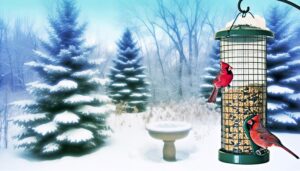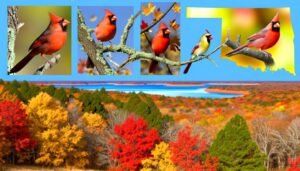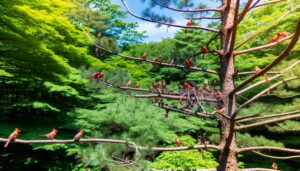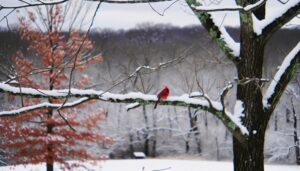10 Tips to Attract Bluejays and Cardinals to Your Yard
To attract bluejays and cardinals, offer a variety of foods like acorns, sunflower seeds, safflower seeds, and peanuts. Use platform feeders for bluejays and perch feeders for cardinals.
Place feeders near dense foliage, such as native shrubs or trees, to provide cover and nesting sites. Keep a birdbath with shallow, fresh water to support hydration needs.
Regular feeder sanitation and avoidance of spoiled food deter diseases. Enhance habitat by planting native species like oak and dogwood, and maintain cleanliness to prevent rodents.
These measures create a welcoming environment, encouraging frequent visits and natural behaviors from both bird species. Discover more strategies to perfect your bird-friendly haven.
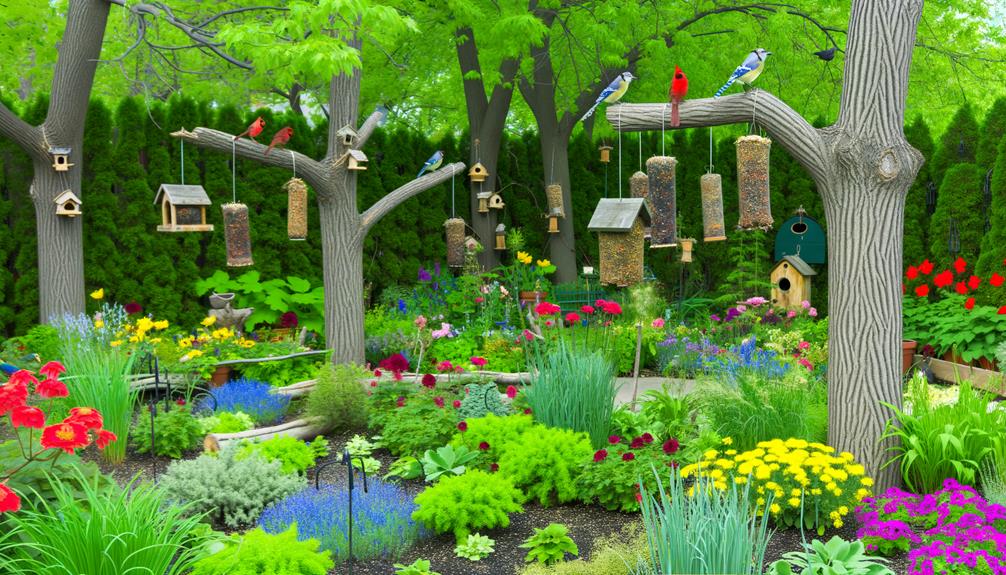
Key Takeaways
- Provide platform and hopper feeders with peanuts, sunflower seeds, and safflower seeds.
- Position feeders near dense foliage or shrubs for natural cover and protection.
- Install a birdbath with fresh, moving water and maintain cleanliness.
- Enhance habitat with native trees and shrubs like oak, dogwood, and elderberry.
- Use nesting boxes and ensure they are clean, properly positioned, and predator-safe.
Understanding Bluejays and Cardinals
To attract bluejays and cardinals, understanding their distinct behavioral patterns and dietary preferences is essential. Bluejays are recognized for their social nature and intricate vocalizations, often imitating other birds. They favor acorns, peanuts, and sunflower seeds.
Cardinals, on the flip side, display more territorial behavior, frequently observed in pairs. They prefer safflower seeds, cracked corn, and fruit.
Research shows that both species value dense foliage for nesting and protection. Observations indicate that bluejays are drawn to oak trees, while cardinals prefer thick shrubs and evergreens.
Selecting the Right Feeders
When selecting feeders for bluejays and cardinals, consider both feeder placement strategies and proper feeder types. Position feeders at varying heights and in locations with natural cover to optimize foraging behavior and predator avoidance.
Research shows that platform feeders and hopper feeders are particularly effective for these species due to their size and feeding preferences.
Feeder Placement Strategies
Choosing the right feeders for attracting bluejays and cardinals hinges on understanding their feeding habits and preferences. Bluejays tend to prefer tray or platform feeders where they can comfortably perch and access food, while cardinals favor feeders with perches that allow them to feed in a more upright position.
Research indicates these birds are more likely to visit feeders placed near shrubs or trees, providing a sense of security and cover from predators. Position the feeders at varying heights to accommodate different feeding behaviors. Guarantee feeders are in visible, accessible locations, yet not too exposed to harsh weather.
Observing these scientific principles will enhance your effectiveness in attracting and serving these vibrant avian visitors.
Proper Feeder Types
Understanding the specific feeder types that appeal to bluejays and cardinals is essential for attracting these species effectively. Bluejays prefer platform feeders due to their larger size, allowing them ample space to perch and feed.
Cardinals, on the other hand, thrive on hopper feeders with wide ledges, accommodating their unique feeding posture. Research indicates that both species are drawn to feeders offering sunflower seeds and peanuts.
For best results, choose feeders made from durable materials like metal or high-grade plastic to withstand elements and deter pests. Placing feeders at varying heights can cater to the distinct habits of each bird, ensuring a harmonious feeding environment.
Choosing the Best Bird Food
Choosing premium bird food significantly impacts the health and frequency of bluejays and cardinals visiting your backyard. Focus on selecting food rich in nutrients to support their vibrant plumage and energy levels. Research indicates that these birds are particularly fond of seeds and nuts. Here's a quick guide to ideal choices:
| Bird Food | Nutritional Benefits | Attracts |
|---|---|---|
| Black Sunflower Seeds | High in fat, protein, and fiber | Bluejays, Cardinals |
| Safflower Seeds | Protein-rich, deters undesirable species | Cardinals |
| Peanuts | High energy, aids in muscle development | Bluejays |
| Suet Cakes | Packed with fat, perfect for winter months | Bluejays, Cardinals |
Serving these foods guarantees you're meeting their dietary needs and promoting frequent visits.
Providing Fresh Water
Securing a consistent supply of fresh water is crucial for attracting bluejays and cardinals to your backyard. Place a birdbath in a visible, elevated spot to lessen predation risk. Opt for a shallow basin, 1-2 inches deep, to accommodate their bathing habits.
Research indicates that moving water, such as from a small fountain or dripper, is particularly appealing to these species. Refill and clean the birdbath regularly to prevent algae growth and mosquito breeding.
In winter, consider using a heated birdbath to secure a water source during freezing conditions. By providing fresh water, you'll support the hydration and hygiene needs of bluejays and cardinals, fostering a welcoming environment for these vibrant birds.
Planting Native Trees and Shrubs
To further enhance your backyard as a sanctuary for bluejays and cardinals, plant native trees and shrubs that provide shelter, nesting sites, and food sources.
Select species like oak, dogwood, and serviceberry, which offer high nutritional value through their berries, nuts, and seeds. According to ornithological studies, these trees support diverse insect populations, fundamental for feeding young birds.
Shrubs such as elderberry and spicebush create dense foliage, offering protection from predators. Research indicates that native plants are more resilient and require less maintenance, benefiting both you and the ecosystem.
Creating Safe Nesting Spots
For finest bluejay and cardinal nesting, strategically place nesting boxes and natural materials like twigs and leaves in secluded areas of your backyard. This will simulate a natural habitat, reducing stress and increasing nesting success. Make sure the nesting boxes are elevated and positioned to face away from prevailing winds, providing ideal shelter. Research indicates that bluejays prefer dense foliage while cardinals favor open spaces with nearby cover.
- Use untreated lumber: Avoid chemicals harmful to birds.
- Ensure predator defenses: Protect nests from raccoons and cats.
- Install roosts: Facilitate easy access and monitoring.
Using Bird Baths Effectively
To attract bluejays and cardinals, maintain an ideal water depth of 1 to 2 inches in your bird bath, as these species prefer shallow water for bathing.
Regularly clean the bath to prevent algae buildup and mosquito larvae, which can deter birds and pose health risks.
Research indicates that consistent upkeep and appropriate depth markedly increase avian visitation rates.
Water Depth Preferences
Different species of birds, like bluejays and cardinals, show distinct water depth preferences when using bird baths, with most preferring shallow depths of about 1 to 2 inches.
To address these preferences, you should consider the following:
- Gradual Slopes: Guarantee the bird bath has a gentle incline for easy access and safer footing.
- Varied Depths: Provide sections ranging from 1 to 2 inches deep to accommodate different species.
- Textured Surfaces: Utilize baths with textured bottoms to prevent slips and offer grip.
Research indicates that birds are more likely to frequent baths that replicate natural water sources. By adjusting water depth and surface texture, you'll create an inviting habitat for bluejays and cardinals, improving their hydration and bathing needs.
Regular Bath Maintenance
Maintaining bird baths regularly guarantees bluejays and cardinals enjoy clean, safe water, which is crucial for their health and well-being. Clean the bath every few days to prevent algae growth and bacterial contamination. Scrub the basin with a mixture of one part white vinegar to nine parts water, then rinse thoroughly. Make sure the water level remains between 1-2 inches, ideal for drinking and bathing.
| Task | Frequency | Purpose |
|---|---|---|
| Scrubbing Basin | Every 3 days | Prevent algae and bacteria |
| Water Replacement | Daily | Maintain cleanliness |
| Vinegar Solution | Weekly | Deep clean to eliminate pathogens |
| Level Check | Daily | Ensure ideal water depth for birds |
Maintaining Clean Feeding Areas
Why is it important to keep feeding areas clean?
Clean feeding areas prevent disease, deter pests, and ensure the health of both bluejays and cardinals. Contaminated feeders can harbor harmful bacteria and mold, leading to avian illnesses.
You'll want to follow these steps to maintain prime hygiene:
- Regularly sanitize feeders: Use a 10% bleach solution to disinfect feeders weekly.
- Remove spoiled food: Check daily for damp or moldy seeds, and discard them immediately.
- Maintain ground cleanliness: Clear fallen seeds and debris to deter rodents and prevent fungal growth.
Research shows that clean feeding areas noticeably reduce the risk of disease transmission among bird populations.
Offering Shelter and Cover
To attract bluejays and cardinals, you'll need to focus on providing suitable shelter and cover. Research shows that natural plant cover and strategically placed nesting boxes greatly enhance their habitat.
Additionally, evergreen trees offer essential year-round refuge and protection from predators.
Natural Plant Cover
Creating a habitat with thick shrubs and indigenous trees provides essential shelter for both bluejays and cardinals, enhancing their chances of survival and breeding success. Thick vegetation offers protection from predators and harsh weather, while also supplying food sources like berries and insects.
Consider planting a variety of indigenous species to create a layered environment.
- Thick Shrubs: Planting species such as dogwood, viburnum, and elderberry can offer both cover and food.
- Indigenous Trees: Oaks, maples, and pines provide height and additional shelter.
- Ground Cover: Incorporate ground cover plants like ferns and grasses to create a comprehensive habitat.
Nesting Box Placement
In addition to natural plant cover, strategically placing nesting boxes can provide bluejays and cardinals with secure sites to raise their young, enhancing their breeding success. Position your nesting boxes at least 6-10 feet above ground to deter predators.
Face the entrance away from prevailing winds to protect nestlings. Research indicates that bluejays prefer nesting boxes with dimensions of 8×8 inches, while cardinals favor open-front designs.
Ensure the boxes are made of untreated wood to avoid harmful chemicals. Regularly clean and inspect the boxes to maintain a healthy environment. By following these guidelines, you'll offer these birds a safe habitat, thereby fostering their population growth and contributing positively to your local ecosystem.
Evergreen Trees Importance
Evergreen trees play a crucial role in providing year-round shelter and cover for bluejays and cardinals, ensuring their protection from harsh weather and predators. These trees offer dense foliage that remains intact throughout the seasons, creating a reliable sanctuary.
Research has shown that evergreens:
- Enhance survival rates by offering a consistent habitat during winter months.
- Facilitate nesting by providing stable branches and ample cover.
- Encourage territorial behavior, important for breeding and feeding.
You'll find that planting a mix of pine, spruce, and fir trees will greatly benefit these birds. Observations confirm that evergreens help maintain a stable microclimate, important for thermoregulation.
Avoiding Predators
Why is it important to implement strategies to protect bluejays and cardinals from predators, especially when their vibrant plumage makes them easily identifiable targets? Predation risk increases with visibility. To safeguard these birds, employ research-based methods. Set up birdhouses with entrance holes sized to exclude larger predators. Position feeders away from dense cover where cats or hawks might hide. Utilize baffles on poles to deter climbing predators. Plant thorny bushes nearby as natural deterrents.
| Strategy | Description |
|---|---|
| Birdhouse Design | Small entrances exclude larger predators |
| Feeder Placement | Place away from dense cover |
| Pole Baffles | Prevent climbers like raccoons and squirrels |
| Thorny Bushes | Natural deterrents for ground predators |
| Visual Deterrents | Reflective objects to scare away predatory birds |
Apply these strategies to guarantee a safer environment for bluejays and cardinals.
Seasonal Feeding Tips
Tailoring your feeding practices to the changing seasons guarantees bluejays and cardinals receive excellent nutrition and energy throughout the year. In winter, provide high-fat foods like suet and sunflower seeds to help them maintain body heat.
Spring calls for protein-rich options such as mealworms to support breeding and molting.
In summer, focus on hydration and offer fruits like berries, which are rich in vitamins and antioxidants.
Scientific research shows that adjusting food types seasonally enhances birds' survival and reproductive success. Observing these practices assures you're not just feeding them, but also contributing to their overall well-being and ecological balance.
Observing Bird Behavior
Observing bird behavior provides invaluable insights into the feeding, mating, and social habits of bluejays and cardinals, allowing you to better tailor your backyard environment to their needs. Bluejays exhibit territorial aggression, especially around feeding stations, while cardinals prefer a more secluded area for their nesting sites. By noting these patterns, you can optimize feeder placement and nesting material availability.
| Behavior Type | Observation Detail |
|---|---|
| Feeding | Bluejays dominate feeders; cardinals forage on the ground. |
| Mating | Cardinals perform courtship feeding; bluejays engage in aerial displays. |
| Nesting | Cardinals choose dense shrubs; bluejays use tree branches. |
| Social Interaction | Bluejays form small flocks; cardinals often pair up. |
| Vocalization | Bluejays vocalize loudly; cardinals have melodic songs. |
Such detailed observations will help you fulfill their specific needs effectively.
Enhancing Your Bird Habitat
Building on your observations of bird behavior, you can strategically enhance your bird habitat to attract more bluejays and cardinals by focusing on specific elements that cater to their feeding, mating, and nesting preferences.
Bluejays prefer dense foliage for nesting, while cardinals thrive in areas with abundant shrubbery. To create an inviting environment:
- Plant Native Flora: Utilize regional plants that provide natural food sources and shelter.
- Water Sources: Install birdbaths or small ponds to offer hydration and bathing opportunities.
- Feeding Stations: Position feeders stocked with sunflower seeds, peanuts, and suet to meet their dietary needs.
Conclusion
By following these detailed strategies, you'll transform your backyard into a welcoming sanctuary for bluejays and cardinals.
Think of your space as a thriving ecosystem, where every feeder, plant, and water source acts like a carefully placed puzzle piece.
Your observations and research-based efforts won't only attract these stunning birds but also provide them with a habitat to thrive.
So, get started and enjoy the vibrant colors and lively songs filling your garden.

